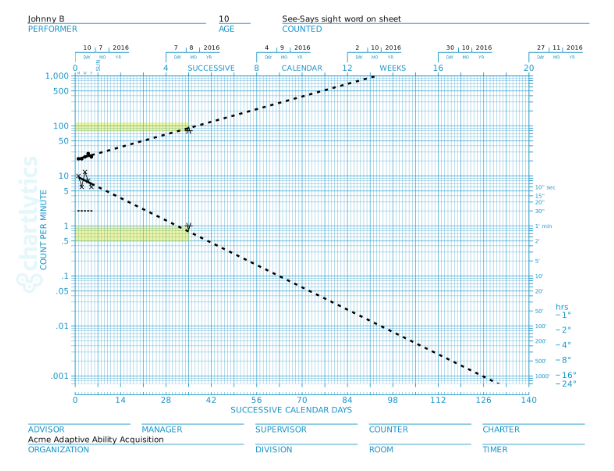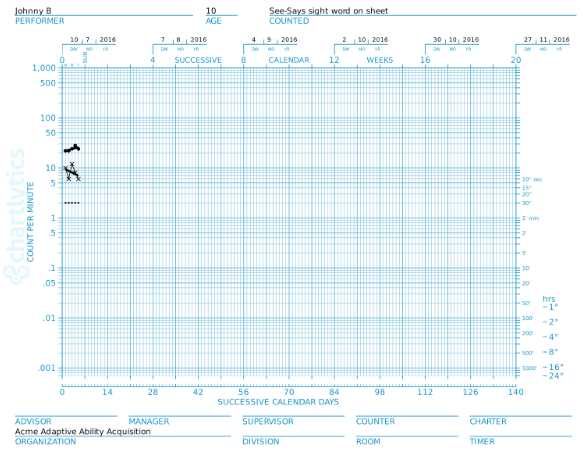Written by Amy Evans
I’ve spent a lot of time lately with folks who are trying their hand at Precision Teaching for the first time. Through this process, I’ve learned a lot about common “rookie” mistakes and have been reminded of those I made while getting started. It is amazing to watch people transform into Precision Teachers as they embrace precise measurement and strive for effective teaching practices.
Here’s a rookie move that I found surprising, and surprisingly common: People go through all the work to pinpoint a behavior, create teaching materials, measure and chart behavior on the Standard Celeration Chart… but their charts have no aims!
The utility of aims
I don’t know who said it first, but in these moments I’m reminded of the saying, “without aims, you’re aimless.” It’s true! Without a goal in mind, how do you know how far you have to go? How do you determine when it’s time to move on to another target?
Here’s what I mean.
This is a chart with an aim star to represent the frequency aims for both acceleration and deceleration pinpoints.
The aim stars tell me that a performance of 120-80 correct words per minute and 0-1 incorrect words per minute is most likely to indicate fluent sight reading behavior. They also provide a visual anchor representing the time left to practice this pinpoint+ (in this case, I have a total of five weeks with Johnny before he goes back to school).
After a few days of practice, my celeration lines can be projected out. Both my acceleration and deceleration projections reach their respective aim stars. It looks like, if Johnny continues to practice, he will hit aim (and be fluent) right on time!
Here’s the exact same chart without aim stars.
Looking at this chart, I can see that correct words are increasing and incorrect words are decreasing. I can look at celeration values to determineby how much these performances are changing over time, but I cannot determine how long it might take to achieve optimal frequency. For this reason, I can’t make any recommendations about whether to stay the course or make a change to insure adequate progress in the time I have with Johnny.
What’s in an aim?
Now that we know a bit more about the utility of aims, here are a few more things you should know about them:
- Aim = “Performance Standard.” These terms are interchangeable in Precision Teaching.
- An aim is typically a range of frequencies within which fluent behavior is observed.
- The higher frequency often comes first (ie, 100-80) to encourage teachers and students to shoot for the higher frequencies.
- Reaching these aims tends to be predictive of the outcomes associated with fluency (Maintenance, Endurance, Stability, Application, and Generativity, or MESAG).
- Many of the aims used in Precision Teaching have been empirically validated through years of research and classroom practice.
Finding and creating aims
I think a lot of people know these things already, and yet…aimless charts persist! Why is this? Well, it turns out, aims are kind of tricky. People are unsure whether or not they exist for certain pinpoints. If they do exist and can be found, it’s not very clear where they come from and whether they are appropriate for certain learners. Often times, practitioners and organizations create new pinpoints for their learners but have no formal process for creating associated aims.
Let’s see if this quick guide helps…
Step 1: See if the aims are already out there
The Precision Teaching Book has a long list of Performance Standards from Precision Teaching literature in the Appendix. Dr. Kubina shared it with me to share with you — check it out here.
If you buy materials created by Precision Teachers (ie, Morningside Press,Haughton Learning Center, The Maloney Method, Essential for Living, to name a few), aims are often included with practice materials. You can assume all of these aims have been tested with many learners. If you’re ever unsure, contact the author.
No luck? If you can’t find an aim for your pinpoint+, try:
Step 2: Get a sample
The best sample would include a range of performers who are competent in the skill area related to your pinpoint.
It’s good to start with professional adults for a few reasons:
- Unless you work alone, there should be plenty of these in your workplace.
- For many skills, it is easy enough to assume most adults are fluent in the behavior of interest.
- Sampling a bunch of adults is quick and easy. You usually don’t have to spend much time explaining the task or helping them time and count their behaviors.
- It can also be a nice way to interrupt a work day with 1-2 minutes of aim-setting timings. Have fun with it!
Another option is to look at performances from a sample of peers or near-peers to the performer for whom the pinpoint was selected. This can help you be sure your aims are appropriate for your learners. But be careful! Look for peers who are assumed to be masterful in the behavior of interest. We’re not looking for norms or averages because performing at the 50th, or even 80th percentile for one’s grade is nowhere near synonymous with fluency.
Helpful Hints
Here are a few additional considerations for setting aims.
Look out for fatigue (time matters!)
An important part of an aim is the terminal timing length (the optimal counting time at which a performance can be considered masterful). If the folks you are sampling start slowing down in the middle of the timing, this may be a pinpoint you want to practice at shorter timing lengths.
Consider the learning channel
Be sure to set an aim that is appropriate for the learning channel. For example, the aims I’ve used for math facts vary drastically depending on the learning channel:
See-Say answers addition fact: 100-80 answers per minute
See-Write answers addition fact: 80-60 answers per minute
Hear-Say answers addition fact: 40-30 answers per minute
Watch out for potential ceilings
Ceilings are especially important to consider when working with young kids or those with physical limitations. Aims for targets that require writing, like math facts or writing words, should never be higher than a learner’s frequency of Free-Writes letters or numbers. Similarly, it may not be appropriate to set an aim for See-Say targets that is higher than a learner’s conversational speaking rate.
Remember what you are counting
Look back at your pinpoint+ for reminders about whether you are counting digits or answers, letters or words. In my experience, whenever an aim feels “not quite right,” it is usually because my aim and count don’t align.
Getting aims on a chart
Now that you’ve established an aim, get that aim on your chart!
There are two methods for displaying your aims on a Standard Celeration Chart.
If you have a hard “deadline” for achieving fluent performance, the aim star is your best bet. On Chartlytics, you can enter the calendar days to aim when creating or assigning your pinpoint, and the aim star will be placed on that date on your chart.
If you’d prefer not to pick a date for reaching aim, you can simply enter your aim range, and the yellow band will appear across your entire chart.
Follow the data
As you work on the skill with your learner, keep an eye on celeration as well as the distance between current performance and the aim bar. This will help guide your precision decision making (should you continue, change, or complete).
Check for the indicators of fluency: Maintenance, Endurance, Stability, Application, and Generativity (MESAG). If you get all those before reaching aim, you may be able to move on. If you get to aim but aren’t getting these outcomes, consider modifying your aims.
Staying true to your aims
At some point in the process, you will doubt the aims you’ve set. You’ll think, “am I expecting too much?” You will consider changing your aims, and, as a result, lowering your expectations. Don’t!
The ‘resource’ child has been too frequently branded with the reputation of ‘slow learner’. Teacher expectations very often follow suit. Fortunately, evidence contrary to that kind of thinking and feeling is being produced by those who ‘care enough to chart.’ —Bower & Meier, 1981, p. 27
If you find yourself concerned about your aims being too high and your learners being too low, consult the literature on fluency and precision teaching. This has helped cure my second-guessing tendencies in the past.
References
Beck, R., & Clement, R. (1991). The Great Falls Precision Teaching Project: A historical examination. Journal of Precision Teaching, 8(2), 8-12.
Binder, C. (1996). Behavioral fluency: Evolution of a new paradigm. The Behavior Analyst, 19, 163-197.
Bower, R. & Meier, K. (1981). Will the real slow learner please stand up? Journal of Precision Teaching, 11(2), 25-27.
Freeman, G., & Haughton, E. (1993a). Building reading fluency across the curriculum. Journal of Precision Teaching, 10, 29-30.
Freeman, G., & Haughton, E. (1993b). Handwriting fluency. Journal of Precision Teaching, 10, 31-32.
Haughton, E. C. (1972). Aims: Growing and sharing. In J. B. Jordan & L. S. Robbins (Eds.), Let’ s try doing something else kind of thing (pp. 20-39). Arlington, V A: Council for Exceptional Children.
Haughton, E. C. (1982). Considering standards. Journal of Precision Teaching, 3, 75-77.
Johnson, K. R., & Layng, T. V. J. (1996). On terms and procedures: Fluency. The Behavior Analyst, 19(2), 281-288.
Johnson, K.J. & Street, E.M. (2012). From the laboratory to the field and back again: Morningside Academy’s 32 years of improving students’ academic performance. The Behavior Analyst Today, 13(1), 20-40.
Koorland, M.A., Keel, M.C., & Ueberhorst, P. (1990). Setting Aims for Precision Learning. Teaching Exceptional Children, 22(3), 64-66.
Kubina, R. M. & Morrison, R.S. (2000). Fluency in Education. Behavior and Social Issues, 10, 83-99.
Kubina, R. M., & Yurich, K. K. L (2012).The Precision Teaching Book. Lemont, PA: Greatness Achieved.
Lindsley, O. R. (1990). Precision teaching: By teachers for children.Teaching Exceptional Children, 22(3), 10-15.
Lindsley, O. R. (1995). Ten products of fluency.Journal of Precision Teaching and Celeration, 13, 2-11.
Mercer, C. D., Mercer, A. R., & Evans, S. (1982). The use of frequency in establishing instructional aims.Journal of Precision Teaching, 3(3), 57-63.










